Abstract
The influence of road infrastructure over the severity of road accidents, in particular some specific features of it, represents the subject of this study. Generally, when an accident occurs, its causes are represented by a number of factors such as driver experience, fatigue, driving under the influence of alcohol and other psychoactive substances, road configuration, weather conditions, speeding, distracted driving, and unsafe road infrastructure. Road design is a key factor regarding the safety of all traffic participants. In this paper, the influence of unsafe roadside element designs on the incidence of traffic accidents, the degree of vehicle passenger injury, and the level of car damage were investigated. The present study was inspired by the high number of accidents produced on European route E68 (DN1) in Romania, a significant part of which was generated and accentuated by the effects of improper roadside design.
1. Introduction
Road accidents and their causes and effects represent a major problem for any country from a medical, social, and economic point of view. In this context, identifying and understanding the complex factors that affect road accidents represent an essential research field for road safety.
Therefore, the need to improve road safety must be a mandatory objective for transport authorities, which can be met through certain strategies, such as new or improved infrastructure, tougher legislation, traffic participant education, etc. The sooner strategies are used to intervene on the contributing factors of road accidents, the more visible the preventive effect will be.
All these aspects must be included in a safety system approach [1] based on suitable procedures, methods, and policies in order to develop and improve road safety. The interest for studying factors affecting road safety—the effects of road and traffic characteristics—represents a dynamic field in continuous evolution.
The European Road Safety Observatory (ERSO) provides reliable and comparable data about road accidents, detailed information and analysis about road safety trends, and procedures and policies in the European Union (EU). Considering the ERSO annual report, the 2023 report reveals stalling progress in reducing road fatalities in too many countries [2]. Despite this, reducing traffic accidents and their fatalities and improving road safety represent a continuous concern for the EU.
In this regard, the European Commission [3] set a target for 2030 to halve the number of serious injuries in the EU, considering 2020 as a landmark, and set an ambitious objective of minimizing towards zero fatalities in the long term for the year 2050, termed “Vision Zero”.
This goal aligns with the United Nations resolution [4], which declared the period 2021–2030 as the Decade of Action for Road Safety, with the target of preventing at least 50% of all road traffic injuries and fatalities by 2030.
Going back to the ERSO report, it also reveals that Romania is characterized by one of the highest incidence of road accidents in the EU. Ref. [5] reveals that among the most common causes are excessive or inappropriate speeds, especially in bad weather conditions. In Romania, most road accidents take place on national roads, but it is important to mention that the most frequent fatal accidents take place on highways. Over 30% of the serious accidents that have occurred have been on national roads. It must be admitted that it is not only an infrastructure problem but also includes the fact that the accidents were caused by people.
The year 2022 represents the starting point of the National Road Safety Strategy implementation for the period of 2022–2030. The main directions of action stipulated by it are a high-performance management of road safety, safer conditions for the use of roads, increased security conditions for the infrastructure, and prevention and monitoring, as well as optimal interventions in cases of emergency situations [5].
In order to achieve similar goals, [1] foresees the implementation of a Safe Systems procedure for road safety, based on the following main elements:
- Human behavior—considering that no matter how well people are trained for responsible road use, they can make mistakes, and road infrastructure must be developed while taking this aspect into account.
- Human frailty—consisting of the limited resistance of the human body to various types of collisions and mechanical stress, the assessment of the injury risk, and the severity of injuries. It represents another design criterion.
- Forgiving systems—meaning that any human error must not be potentiated by the road, correlating with vehicle type and interaction with other traffic participants.
The forgiving roads concept [6] assumes the minimization of driving error consequences, rather than preventing them, and this is mainly because of the human factor, which can be estimated.
Having this principle as a guideline, the entire road infrastructure must comply with the following:
- Minimize the risk of vehicles leaving the carriageway by using vehicle active systems (e.g., line assist), correlated with appropriate road delineation.
- Provide an adequate stopping distance or recovery area when a car runs off the road.
If a collision still occurs with any roadside obstacles, it is mandatory that impact forces transmitted to the vehicle occupants be kept at minor levels (i.e., no fatal or serious injury outcomes). According to [7,8], the main approaches for studying road safety are represented by infrastructure characteristics (e.g., road type and configuration and investment levels), the environment (e.g., road geometrical design and weather conditions), and traffic conditions (e.g., vehicle types and traffic volume). These elements are critically related because proper road infrastructure will have a beneficial impact on the number and severity of accidents. Any other contradictory assumptions can be considered subjective, being dependent on drivers’ experience and education.
An important aspect in the context of infrastructure sustainable development is to identify the risk factors related to it and their impact on road safety. It becomes obvious that such an in-depth analysis is specific to every EU country, for all road types, considering aspects such as road infrastructure design, environmental factors, and traffic volume and control.
Contributing factors to road accidents can be grouped as follows [7]: human factors (e.g., experience, fatigue, distracted driving, speeding, risky overtaking, and the influence of alcohol and/or psychoactive substances), road infrastructure factors (e.g., road type, surface type, road segment configuration—alignment, curve, tunnels, and junctions—and road side configuration), traffic factors (e.g., vehicle mix and density—congestion), environment and weather (e.g., winding road, fog, rain, frost, and snow), and vehicle design and physical conditions (e.g., safety systems, suspension condition, and tire wear).
In the above classification of road accident favoring factors it is mandatory to include weather conditions too, because in many circumstances they represent an aggravating factor in the frequency of accident occurrence [9,10] (accident risks are significantly higher during bad weather conditions). The meteorological phenomena type (e.g., rainfall intensity, fog, snow, etc.) is another element that must be considered during the road infrastructure design process, as well from the perspective of the forgiving roads concept [1]. Adverse weather conditions influence a driver’s visibility (driver’s standard reaction time is extended), reduce the friction coefficient between tires and carriageway, extend the stopping distance, while in the worst-case scenario they will determine the skidding and aquaplaning of the vehicle.
From the above analyses regarding the factors favoring the occurrence of accidents, having in mind [6], it becomes obvious that in addition to the human factor, any road infrastructure improvement can either prevent or, in the most pessimistic scenario, reduce the effects of human errors. So, a proper road system design can prevent human errors and this will be materialized in less traffic accidents. Ref. [6] considers three principles in order to prevent human errors during driving: keeping away from an unintended road use; avoiding considerable differences in direction, mass, and speed; preventing unpredictability amongst road users.
Passing from human error prevention to accident occurrence and injury severity, in [11] they are explained through the engineering system and human behavior as linked factors that represent two major elements of risk. An engineering solution can increase traffic safety, but at the same time it must not influence the driver’s alertness. Road safety engineering and human behavioral adaptation represent key elements in reducing the number of accidents. In this regard [12] considers that road infrastructure design must be done in such a way as to ensure optimal driver behavior in terms of speed, anticipation, and attention. Situations as incorrect visibility of the carriageway, poor anticipation of road curves combined with inadequate speed, poor quality of tires or excessive wear of them, accentuated by unfavorable weather conditions (e.g., rainfall) can favor the occurrence of accidents.
The safe roads concept, in particular self-explaining roads [13], involves an understandable one from the driver’s point of view, considering several important specific elements, such as: roadway quality in terms of adhesion and bump free asphalt surface, day and night visibility, predictable road regardless of weather conditions, road markings and traffic signs, road sector optimal geometric configuration, etc. On the other hand, a high density of road signs or markings in a complex traffic scenario, according to [14], may lead to an overload of information and an increased risk of driving errors. An optimal practical combination of those elements is able to level up driver confidence, anticipation, and attention, influencing his reaction time, both for safe driving and to avoid certain dangerous situations within reasonable limits.
Considering all the above presented aspects, by evaluating the dependence between infrastructure features and drivers’ behavior, including limit situations, it is possible to decrease or suppress traffic accidents, especially those generated by the faulty design of road infrastructure.
Therefor it is mandatory to analyze accident causes and develop efficient countermeasures to eliminate these causes, by carrying out professional road safety analyses with appropriate implemented measures.
One of these measures refers to the introduction of consistency rules [6,15] in road design process. Design consistency refers to road geometry conformity with driver expectancy, generating predictability. Theoretically, drivers make fewer errors at geometric features that correspond to their expectations. An inconsistency in road design represents a geometric feature or a feature mix with unusual characteristics that drivers may approach in an unsafe manner. Such situations could lead to speed errors, inappropriate driving maneuvers, and finally to accidents. Their effects can be aggravated by inadequate roadside design, a fact which will be detailed in the following section.
2. The Study Scope
The paper’s goal was to investigate the effect of the unforgiving roadsides on European route E68 (DN1) in Romania, over the degree of vehicle passenger injury, respectively, the level of car damage, and having as a base point specific accidents produced on the road sector between the cities of Brașov and Făgăraș, in Brașov county.
Also, the work aimed to reconstruct through software simulation the probable mechanism of the occurrence of such accidents.
The E68 (DN1) is one of the longest and most used roads in Romania, permanently recording high traffic values. The analyzed sector is a difficult one because of its configuration, and in addition the road sector is characterized by a high rate of accidents.
In the current study continuous hazards are addressed, and the ditches in particular, which generally are parallel to the roadway. The analyzed accidents were caused by vehicle run-off into ditches as can be seen in Figure 1.
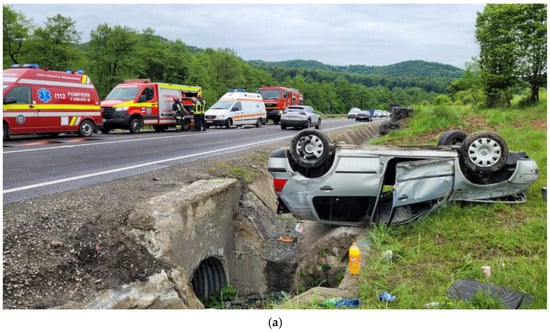
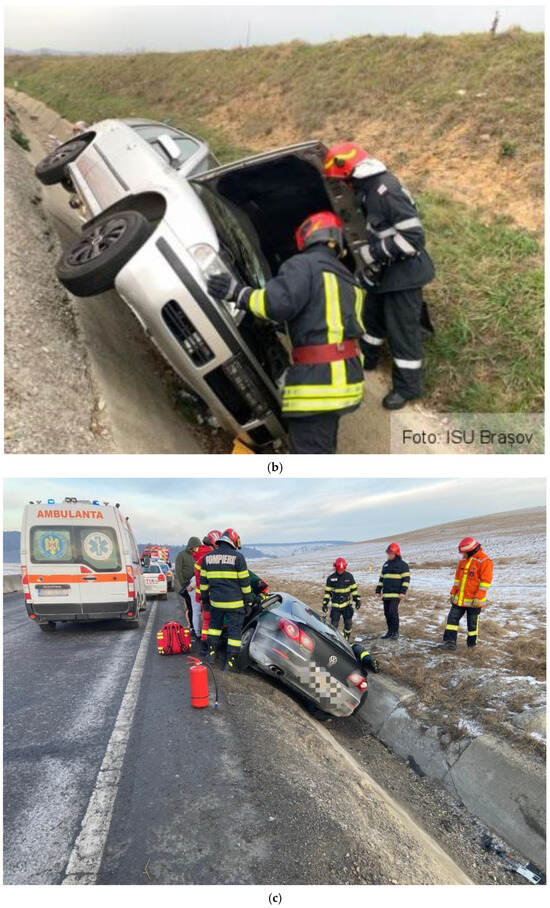
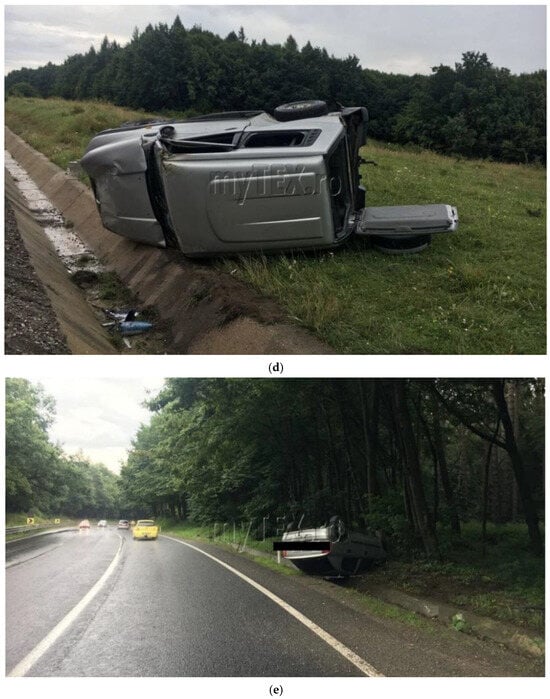
Figure 1.
Examples of accidents with hazardous roadside ditches—(a–e) vehicles overturning, rollover [16]. In the presented context two factors accumulate: first a human error, then accentuated by an unforgiving roadside, a ditch. Thus, the study becomes relevant by establishing the probable collision dynamics, respectively, through analyzing its effect on the vehicle’s occupants. More than this, some forgiving measures are necessary to be implemented in order to compensate such human errors, by reducing or eliminating its effects.
Some relevant crashes are illustrated which occurred on the E68 (DN1) in Romania on the specified road sector. As can be seen in the photos, in most of the cases the impact between vehicle and ditch causes the car to overturn or roll over. In this scenario, apart from the material damage, it is also very important to evaluate the accident effect on the vehicle occupants.
The photos reveal that in most of the cases the vehicle–ditch accidents occurred in adverse weather conditions (wet road surface), a fact that indicates prior vehicle skidding, most likely induced by speeding or by a sudden steering maneuver due to poor understanding of that road section. Also, some photos show that the intervention of medical and extrication crews at the scene of the accidents was necessary, this fact representing an indicator of the crash severity.
3. The Study Background
Generally, as it was mentioned before, there are a multitude of factors that can generate road accidents, related to the following: traffic volume, road type and its configuration, weather conditions, environment, and all categories of road users. In this regard, traffic characteristics (such as speed, density), insufficient driving skills, and road elements (such as geometry, quality and condition of the asphalt surface, roadsides design) can favor the occurrence of road accidents.
National roads in Romania, due to their multiple characteristics, constantly represent the category where a large number of serious road accidents occur, characterized by high values of injury and fatalities, speed being an important generating factor. Statistics show that 20% of serious traffic accidents in Romania are caused by speeding.
Several studies [17,18,19,20,21] analyzed the dependence between speed and accident frequency (accident rate), considering that increased speed causes more accidents. Certain drivers that are speeding, in limit situations, do not know how to manage them, or the reaction time combined with an avoidance maneuver does not allow them to avoid the accidents. In particular, a higher speed will also increase the total stopping distance of the vehicle while the probability of accident occurrence is also higher, especially in wet conditions (slippery road, poor visibility, different friction coefficients on tires, etc.). Thus, by reducing the speed, a decrease in accident rate can be obtained.
On the other hand, speed cannot be seen as a stand-alone factor of accident occurrence, and with the speeding theory it is necessary to include other mixed elements such as the following: variations, road-tire interaction, driver experience, weather conditions, visibility, sudden trajectory change, erroneous estimation of a curve radius, etc.
Another major element in the safety field is the road itself. Its main design characteristics (e.g., geometry, alignment, curves, junctions, and all other infrastructure elements, including roadsides) could play an important role in improving traffic safety. For example, an increased number of curves on a certain road sector can increase the possibility of accident occurrence. This fact can be accentuated by the adverse weather conditions and drivers’ lack of experience in managing the relevant road section. Depending on the particularities of the road sector, the type of accident, and the traffic conditions, only material damages can result, but in certain situations the occupant injuries can also occur. Herein, the improper design of road infrastructure can affect in a negative manner the road safety.
According to [14] a significant percentage of fatal road accidents in the EU are single-vehicle type accidents, classified as run-off-road accidents (vehicle leaves the carriageway and crashes to the roadside).
Roadside hazards can be grouped as follows [1,14]:
- Single fixed obstacles (e.g., trees, vegetation, utility poles, road signs, safety barrier terminations, rocks, drainage features, etc.);
- Continuous hazards (e.g., ditches, slopes, road restraint systems, curbs, etc.);
- Dynamic roadside hazards (e.g., pedestrian and bicycle facilities, parking).
In Romania, the special characteristics of the road (e.g., curve, tunnel, bridge, intersections, railway crossing, etc.) can be the generating factors for the occurrence of road accidents. Similarly, in this study for the analyzed years (2020, 2021, and 2022), the curve and the intersection represent the infrastructure elements with a high potential risk of accidents (Table 1, number of accidents per year). Ref. [22] represents the source of statistical data that are analyzed in the present section of the study.

Table 1.
The situation of road accidents according to the characteristics of the road.
The global analysis of the fatality index for the time period of 2020 to 2022 shows comparable values for the accidents in the case of the curve as the main characteristic of the road and for the case of the road without any specific characteristics (e.g., without curve or/and intersection—Figure 2). Although serious road accidents occur more frequently in intersections than in curves, the comparative statistical analysis indicates that the number of fatalities is lower in the intersection events (Table 2). It can also be mentioned that the highest rate was recorded for serious accidents in the case of the two analyzed characteristics, curve and intersection (Figure 3, Table 3).
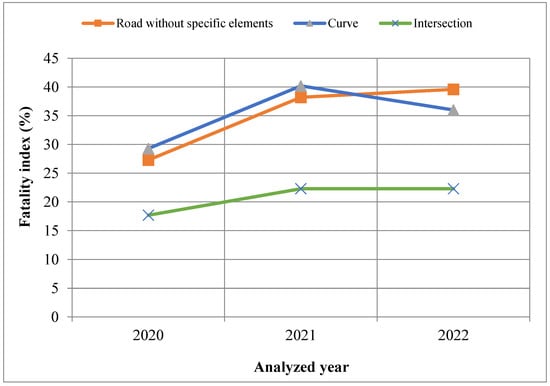
Figure 2.
Comparative analysis of fatality index.

Table 2.
Serious road accidents depending on road characteristics.
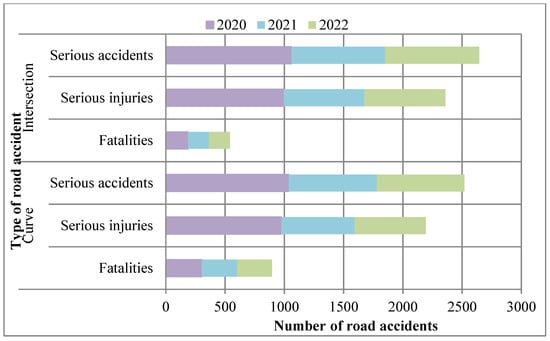
Figure 3.
Accident analyses for the period 2020–2022.

Table 3.
Fatality index.
4. Methodology
The literature regarding the vehicle ditch accident type is relatively limited [17], an experimental study being complex, expensive, and involving a considerable volume of work. A viable alternative solution is the software simulation of such a situation, considering as input data all the involved elements (e.g., vehicle rest position, deformations, road sector geometrical parameters, ditch main dimensions, weather condition, etc.). Through simulation, realistic results can be obtained and valuable information regarding the dynamics of this impact type (vehicle and occupants).
In the case of vehicle overturning or rollover, the strength of the vehicle body is an essential fact from the point of view of deformation amplitude, correspondence with occupant injury being a major factor regarding passive safety improvements.
Generally, overturning accidents have as the main cause cornering at high speeds, when the centrifugal force of the vehicle’s mass is high enough to generate the overturning moment. A particular situation is represented by the impact of the wheels from one side of the vehicle with an obstacle on the roadside (ditch, curb), with overturning either or not preceded by skidding.
During the movement of the vehicle, sudden variations in the transversal inclination of the vehicle body appear as a result of the vehicle wheels from one lateral side passing over the ditch. The imbalances of the vertical reactions on the wheels generate a moment that produces overturning and eventually subsequent rolling.
4.1. Preliminary Data
As mentioned and illustrated previously, the present paper was inspired by specific traffic accidents (vehicles that run off into ditches) produced on the E68 (DN1) in Romania on the Brașov–Făgăraș sector; one important aggravating factor is the unforgiving roadsides, and bad weather conditions are also another element to be considered.
To carry out the study a relevant curved road sector with an unforgiving continuous element was chosen (Figure 4), where the main geometrical parameters of the ditch were measured. Other relevant geometrical elements (e.g., curve radius) of the considered road sector were imported from Google Maps application in the simulation software, including the map zone.
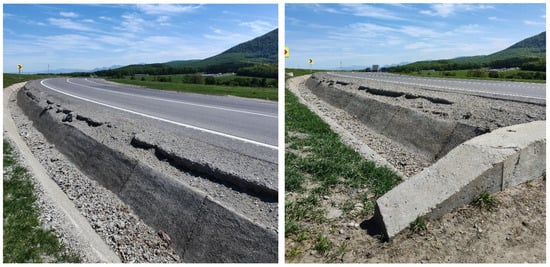
Figure 4.
E68 (DN1)—curved road sector used for the study.
The aspects from photos regarding the vehicle positions, materialized damages, road conditions and roadsides represented the starting point in the development of the simulation, which allows the analysis of the dynamics of the accident.
4.2. Accident Simulation Scenario
For the simulation of vehicle–ditch collision, the specialized software PC-Crash 13.0 was used, that enables the reconstruction and analysis of various traffic accidents. The simulation goal was to investigate the cumulated effect of certain factors—curved road, weather conditions, unforgiving roadsides—over vehicle dynamics and occupant injury in the case of a vehicle that skids and runs off into the ditch, shown in Figure 4. The simulation scenario is a complex one and needs to consider and model a lot of parameters regarding road configuration, vehicle and occupant dynamics, including weather conditions that favor the occurrence of the event.
In order to generate the accident scene, the specific zone from Google Maps was imported in the PC-Crash 13.0 software, then a 3D road object tool was used to generate the specific road configuration, including the main ditch geometrical parameters (Figure 5).
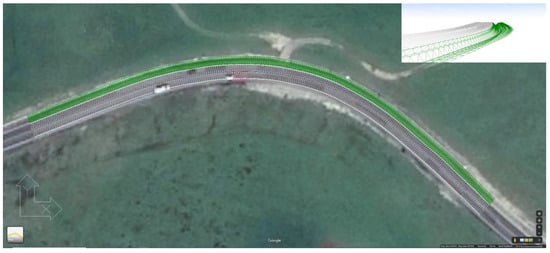
Figure 5.
Simulation scene, ditch profile—E68 (DN1).
The simulation was conducted for rainy weather conditions, a preponderant scenario for such accident occurrence, and the coefficient of friction between wheels and carriageway was adopted accordingly (wet conditions).
As the vehicle for the simulation, an SUV type was used as this kind of vehicle is very popular in EU (in Romania, too). The vehicle dynamic parameter setup (e.g., speed, acceleration, braking, etc.) was made according to the geometrical road configuration and in such a manner as to accurately simulate a real-life vehicle skidding in the initial phase of the vehicle’s movement into the curve, and after that the vehicle runoff into the ditch. In order to obtain a realistic accident mechanism and dynamics, the simulation parameters were continuously modified and optimized through iterations (e.g., speed, acceleration, braking, reaction time, etc.), until boundary conditions—vehicle rest position—were obtained.
For the calculation of movements and loads for vehicle occupants with PC-Crash software, the multibody model was used (Figure 6). Interaction of the occupants with the vehicle interior was also considered. Two restrained occupants were placed in the vehicle, on front seats in order to examine the motion during the impact. The individual bodies of the multibody system are interconnected by joints and for restrained occupants, seat belts are modeled using spring damper elements. In the multibody model, for each body different properties can be specified, like: geometry (a body being defined as an ellipsoid), mass, moments of inertia, contact stiffness, and coefficients of friction [23].
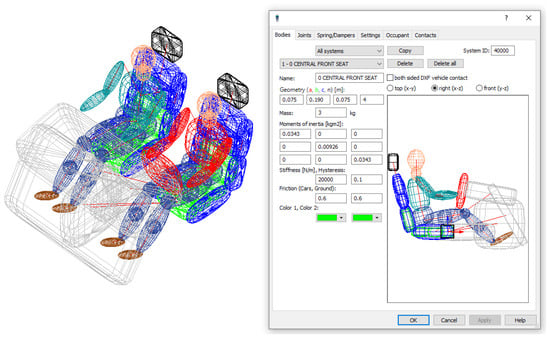
Figure 6.
Multibody model used in simulation.
In Romania the speed limit on European national roads is 100 km/h. On the considered road sector, the input data for the simulation are detailed in Table 4.

Table 4.
Simulation input data.
4.3. Simulation Results
The performed simulation considered two possible scenarios inspired by accidents presented in Figure 1 and are presented as follows:
- (a)
- The vehicle entering into the curve is skidding, leaves the road, and enters into the ditch alongside with its direction of movement.
- (b)
- On entering the curve, the vehicle skids, enters on the opposite direction, and falls into the ditch on the left side of its travel direction. This scenario excluded the possibility of an impact with a vehicle coming from the opposite direction as this aspect is not the object of the present study.
For the proposed scenarios, the performed simulation revealed that the accident occurrence mechanism consists of two different phases: initially, the vehicle skidding appears to be due to the centrifugal force, and then the vehicle overturning and/or rollover is generated by the vehicle–ditch impact. In this case the vehicle overturning occurs independently of the road adhesion, being caused by the moment of the impact force.
These two phases are illustrated in Figure 7 and Figure 8, that consist of successive frames of the accident dynamics at time intervals of 0.4 s for both analyzed cases. In Figure 9 and Figure 10 the vehicle overturning and rollover for the same time intervals are detailed and for both cases.
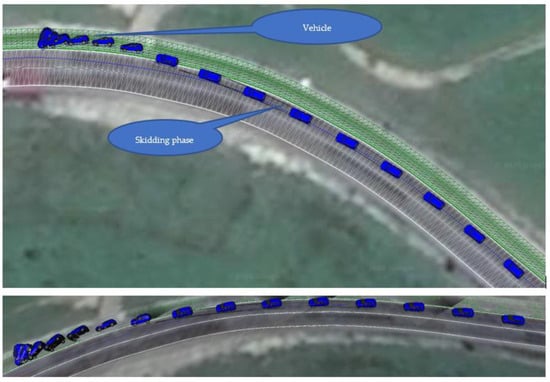
Figure 7.
Consecutive simulation sequences at time intervals of 0.4 s—case (a).
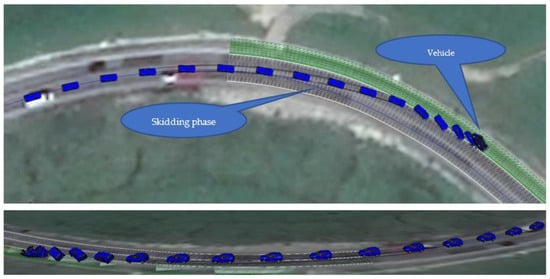
Figure 8.
Consecutive simulation sequences at time intervals of 0.4 s—case (b).
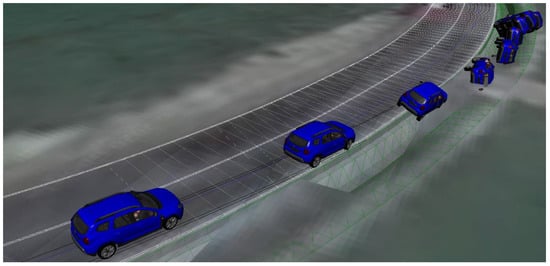
Figure 9.
Vehicle overturning phase—case (a).
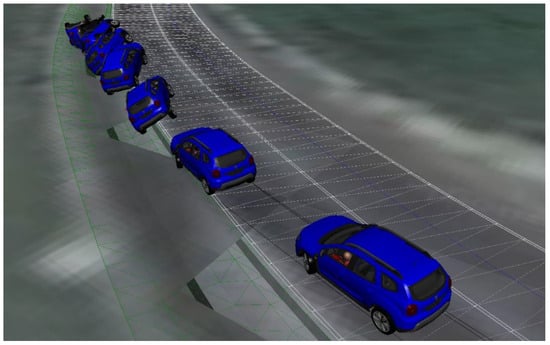
Figure 10.
Vehicle overturning phase—case (b).
In both cases, the skidding phase begins with an instability of the movement, due to the inappropriate behavior of the driver, who did not adapt the speed properly to the road conditions (one of the significant factors that generates accidents in Romania).
The skidding phase that appears is characterized by additional energy consumption due to vehicle lateral deviation and rotation tendency, the friction with the road surface being more intense. The energy consumption is equivalent to the increase in rolling resistance. This phase is considered to be ended when the vehicle leaves the carriageway and starts to fall into the ditch.
Figure 11 and Figure 12 show the vehicle speed variation in time. In case (b) compared to (a), the vehicle speed at the time when it starts to enter into the ditch is lower, 65 km/h versus 79 km/h, the initial speed being the same in both cases. In case (b) the higher initial speed decrease is determined by cumulated factors, such as: driver reaction and braking attempt, the vehicle that is skidding and enters in the opposite direction (the space traveled on the carriageway is superior). Those elements generated a supplementary time that allowed, through controlled and uncontrolled actions, a lower impact speed of the vehicle with the ditch, theoretically with a direct effect on the occupant level of injury (but this is relative, depending also on the impact incidence angle of the vehicle).
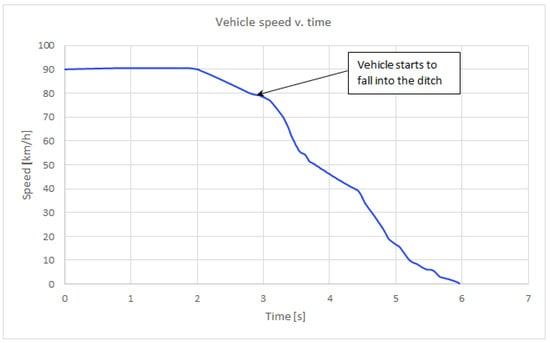
Figure 11.
Vehicle speed—case (a).
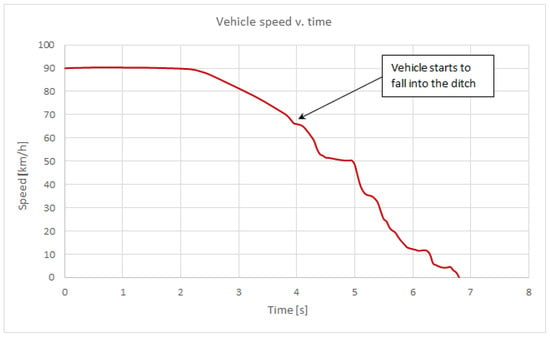
Figure 12.
Vehicle speed—case (b).
The danger of injury to the occupants occurs mainly during the overturning phase, any intervention of the driver being excluded. The occupant level of injury depends in this phase on the vehicle kinetic energy and the obstacle (ditch) profile.
Practically, the overturning phase into the ditch is the one that generates vehicle damage and the injury level of the occupants, depending on the vehicle speed at the beginning of overturning or rollover and speed and acceleration variation during this phase (the initial impact incidence angle has to be taken into account too).
From Figure 11 and Figure 12, it can be seen that the speed drop (kinetic energy, too) during the vehicle–ditch impact is determined by the following mechanism: vehicle body friction with the ditch surface and vehicle body deformation.
The impact between vehicle body parts and the ditch surface is highlighted by the acceleration graphs (longitudinal—long, lateral—lat, and vertical—vert), Figure 13 and Figure 14. A Channel Frequency Classes (CFC) 60 filter was used for processing the impact signals, to eliminate the high-frequency noise and reduce the signal peaks. By comparing the graphs for (a) and (b) cases, it can be seen that the vehicle acceleration dispersion, as impact effect, is higher in case (a), but amplitudes are comparable. Thus, in case (a) predominant are the longitudinal accelerations with a maximal magnitude about 50 m/s2 and lateral accelerations are about 30 m/s2, as a result of the vehicle sliding into the ditch. In (b) case a high amplitude of accelerations is obtained during the rollover of the car, but compared to (a), the time intervals where these peaks are obtained are narrow, about 0.5 s (interval 1, value 40 m/s2) and 0.4 s (interval 2, value 85 m/s2).
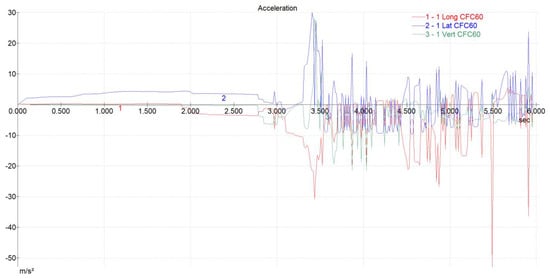
Figure 13.
Vehicle acceleration—case (a).
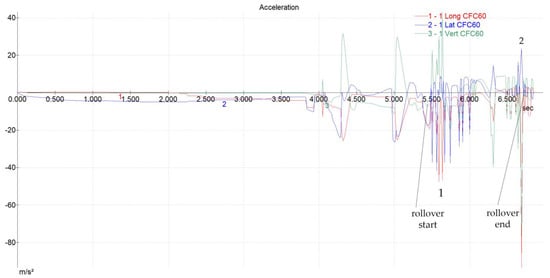
Figure 14.
Vehicle acceleration—case (b).
The simulation frames and acceleration magnitude indicate an increased level of vehicle body damages induced exclusively by contact with the ditch surface. In case (a) the front and right side of the car are damaged. In (b) case, due to the vehicle overturn/partial rollover the entire vehicle body is affected (after a specialized damage evaluation it could be considered total damage).
As mentioned before, for the occupants’ kinematics the multibody module was used. For them, important speed differences occur in the case of collisions with other vehicles or obstacles. High accelerations appear when the vehicle, for example rotates around its longitudinal axis (overturning or rollover).
After the multibody system simulation is performed, the most important data are those related to accelerations, because the severity of the occupants’ injuries depends on them. In the case of the current research, the most susceptible human body parts that can be seriously injured are head and neck. This is because of the possibility of the head hitting the car roof or practically with any hard parts inside the passenger compartment. In this type of accident other elements that can influence the injury severity are: the vehicle size, vehicle body deformation level, rollover number, obstacle size, obstacle that penetrates passenger compartment, etc.
In order to avoid head injury, in theory the acceleration magnitude should not exceed a certain level, as studied through the head injury criterion (HIC) that considers the duration and severity of the impact. According to [24] HIC is the most important parameter regarding human survival. It characterizes the brain injuries due to the impact of the head in vehicle accidents. An alternative evaluation method refers to average acceleration that is greater than 80 g for no longer than 3 milliseconds (ms).
In [25], it is mentioned that the human body supportability limit is about 10–35 g, at gradients of 500–1000 g/s with a maximum duration of 0.15–0.4 s. According to [26] the human body exposure to acceleration higher than 30 g lasting longer than 0.2 s may cause fluid displacement or tissue deformation. The symptoms appear as a blood pressure drop, pulse rate rise, weakness, and skin pallor. These aspects refer to a forward seated position. In the backward-seated position, acceleration up to 35 g can be tolerated without significant difficulties [26].
In the current study, in case (a) (Figure 15 and Figure 16) the maximum obtained value of head acceleration (right-side occupant) was about 240 m/s2, 24 g, that correspond to HIC15 < 130 (equivalent acceleration < 55, for 3 ms) inducing no concussion to the occupant, possibly headache or dizziness, with effects for less than an hour according to [27].
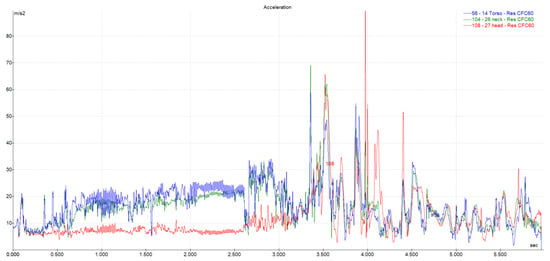
Figure 15.
Driver acceleration—case (a).
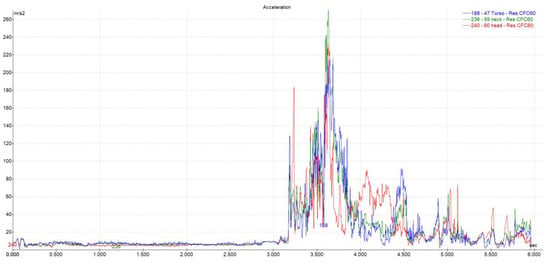
Figure 16.
Front right-side occupant acceleration—case (a).
In case (a) the vehicle entered tangentially into the ditch and an important amount of the kinetic energy of the vehicle was dissipated through the friction between the lateral side and the ditch wall, an effect that contributes to non-injury of the occupants (but this is a particular aspect induced by particular dynamics) and only some temporary, minor effects. For the right-side occupant, the acceleration is higher due the fact that the vehicle hits the ditch first with its right lateral side.
In case (b) (Figure 17 and Figure 18) the maximum value obtained for the acceleration for the driver’s head was about 210 m/s2, that correspond to HIC15 < 130 (equivalent acceleration < 55, for 3 ms) inducing no concussion to the driver, possibly headache or dizziness, with effects for less than an hour according to [27]. The maximum value for acceleration for the right-side occupant was about 412 m/s2, 41 g, a value that corresponds to HIC15 180, the occupant suffering mild concussion according to [27].
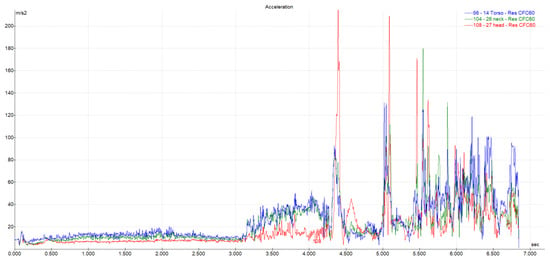
Figure 17.
Driver acceleration—case (b).
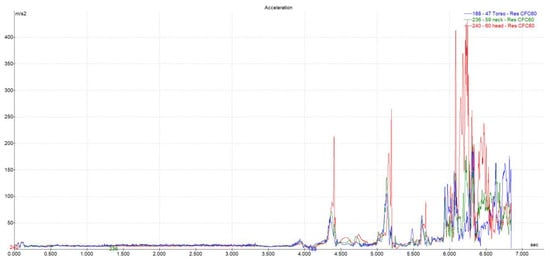
Figure 18.
Front right-side occupant acceleration—case (b).
In the analyzed (b) scenario, the vehicle overturn (partial rollover) induced higher accelerations for both occupants, which indicates a different mechanism of kinetic energy dissipation for that impact type.
5. Discussions and Recommendations
The majority of the accidents involving vehicle overturning or rollover occur outside the carriageway (the vehicle leaves the road and enters the roadside), this type of accident being considered as a run-off-road accident [14]. Every such accident is unique due to its particularities: vehicle type and load, terrain characteristics, obstacles, road design, driver experience and perception, the incidence angle of the impact, obstacle dimensions, etc. If the vehicle during the rollover does not hit any obstacles this kind of accident is less dangerous due the fact that vehicle kinetic energy is dissipated over a longer time compared to a crash between two vehicles.
The objective of the present study was to particularize and analyze the situation when the vehicle’s overturn or rollover was induced by an unforgiving roadside, as the effect of a run-off-road phenomenon. Simulation results show major damage of the vehicle body induced exclusively by the impact with the ditch and obviously a considerable repair cost. In the situation of vehicle rollover, the necessity to replace the car with a new one may have to be considered.
From the performed analysis results that the ditch represents an unforgiving roadside, because due to human error, it caused the actual accident, as it was in contradiction with the concept of a forgiving roadside [1,14]. Through this idea, in the case of a run-off vehicle, the roadside through its design, must either avoid the accident or minimize its consequences.
In this context the most important factor is the health and safety of the occupants and as could be observed this type of accident can affect this in a certain manner. A more dangerous scenario, compared to the analyzed one, could appear anytime in the case of some other types of vehicles, if the driver/occupants are not seat-belted, with different vehicle dynamic parameters, especially including a different vehicle incidence angle with the obstacle (ditch). Different dynamic conditions than those analyzed in the present paper could generate serious injury and vehicle damage.
For both studied cases, the vehicle damages took precedence compared to the level of occupant injury, this being a positive aspect of the research. The injury level was a little bit more serious in case (b). Both scenarios had as starting point the inappropriate road configuration estimation by the driver, materialized by over speeding in wet conditions (a frequent real scenario). Even if the injury level obtained through PC-Crash software simulation was not a significant one for the front occupants, the potential psychological trauma cannot be ignored.
From the presented aspects, the study highlights the influence of an improper roadside design over traffic safety in the case of human error occurrence. Another relevant element that results from the research is the importance of auditing problematic road sectors in order to implement on existing roads the forgiving roadside systems.
Following the elements detailed before in the paper, for the analyzed problem (ditch–vehicle impact) as recommendation, the next solutions can be implemented in order to transform an unforgiving roadside into a forgiving one:
- Cover the ditch and create a safety zone in the proximity of the carriageway, combined with the measure of eliminating extra potential obstacles in problematic areas with a high rate of roadsides accidents. In this manner the vehicle that is out of control will pass over the covered ditch and there will exist the possibility to regain its control or to stop on the field without major or zero damages. It is necessary that the adherence of the covering material be close to that of the asphalt one. This fact is illustrated in Figure 19, where by such a measure, the covered ditch with an appropriate carriageway shoulder represents a recovery area, which will allow the driver in limit situations to perform recovery maneuvers. The effect will be injury free occupants and a vehicle free of damages.
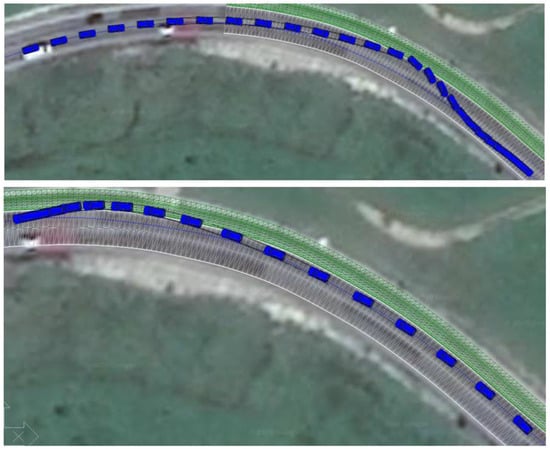 Figure 19. The effect of covered ditch solution.
Figure 19. The effect of covered ditch solution. - Modify ditch slope ratio; the slopes should be kept as shallow as possible. A shallow slope will allow the driver to regain control over the vehicle (Figure 20) [14].
 Figure 20. Examples of safe ditch [14].
Figure 20. Examples of safe ditch [14]. - Isolate the ditch by mounting appropriate roadside barriers (e.g., rolling barrier), that will minimize the effects of a vehicle out of control. This is recommended where a previous solution is not possible through environmental limitations (Figure 21).
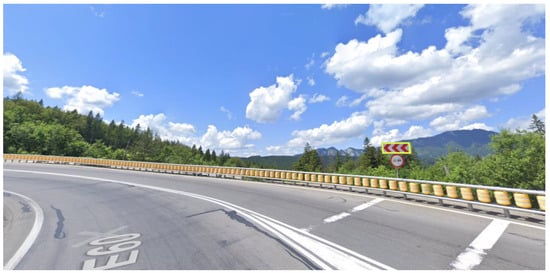 Figure 21. Rolling barrier [28].
Figure 21. Rolling barrier [28]. - Enlarge and pave the road side shoulder (Figure 22), and by that measure, in reasonable limits, a recovery zone is created for the drivers (where it is possible on existing roads), in a similar way to the ditch covering solution presented previously. This is known as a safety zone, where a driver can regain the control over the vehicle.
 Figure 22. Enlarge and pave the road side shoulder—safety zone.
Figure 22. Enlarge and pave the road side shoulder—safety zone.
In this study, a few possible solutions were indicated, through which implementation of real conditions a reduction in frequent roadsides accidents was created and an increase of traffic safety in any conditions obtained, both on the studied road sector and in general on Romanian national roads. The paper had in mind the evaluation of vehicle damage level and occupant injury severity for a simulated situation, inspired by real traffic accidents on the same European road sector. On the other hand, the paper can be seen as an input study for also implementing the concept of forgiving roads in Romania, with real life benefits in reduction of traffic accident and their injury severity.
The forgiving road concept, through its multiple possible technical solutions, will increase road safety and through it, the confidence of all traffic participants during usage of the Romanian national road network.
The study also reveals the practical utility of developing a road safety system, including adequate technical solutions to transform a road into a forgiving one with direct effect on traffic safety. From this point of view the relevant technical solutions and good practices experience can be the starting point for a standardization in the field of road safety.
Funding
This research received no external funding.
Data Availability Statement
The data are contained within the article.
Acknowledgments
The author is grateful to the Transylvania University of Brasov for technical and financial support.
Conflicts of Interest
The authors declare no conflicts of interest.
References
- A Guidance Document for the Implementation of CEDR Forgiving Roadsides Report. National Roads Authority (NRA). Available online: https://www.tii.ie/media/3idngybj/forgiving-roadsides.pdf (accessed on 10 May 2024).
- European Road Safety Observatory (ERSO), European Commission, 2023. Available online: https://road-safety.transport.ec.europa.eu/european-road-safety-observatory_en (accessed on 12 July 2024).
- European Commission, 2020. Next Steps towards ‘Vision Zero’: EU Road Safety Policy Framework 2021–2030. Directorate-General for Mobility and Transport, Publications Office, 2020. Available online: https://data.europa.eu/doi/10.2832/391271 (accessed on 22 May 2024).
- Improving Global Road Safety. Resolution A/RES/74/299, United Nations, 2020. Available online: https://www.who.int/teams/social-determinants-of-health/safety-and-mobility/decade-of-action-for-road-safety-2021-2030 (accessed on 19 May 2024).
- Buletinul Sigurantei Rutiere. Available online: https://www.politiaromana.ro/ro/prevenire/buletinul-sigurantei-rutiere (accessed on 12 May 2024).
- Wegman, F. Influence of Infrastructure Design on Road Safety. In Proceedings of the International Symposium on Traffic Safety, A Global Issue, Kuwait, 15–17 January 1995; 14p. [Google Scholar]
- Papadimitriou, E.; Filtness, A.; Theofilatos, A.; Ziakopoulos, A.; Quigley, C.; Yannis, G. Review and ranking of crash risk factors related to the road infrastructure. Accid. Anal. Prev. 2019, 125, 85–97. [Google Scholar] [CrossRef] [PubMed]
- Albalate, D.; Fernández, L.; Yarygina, A. The road against fatalities: Infrastructure spending vs. regulation? Accid. Anal. Prev. 2013, 59, 227–239. [Google Scholar] [CrossRef] [PubMed]
- Bergel-Hayat, R.; Debbarh, M.; Antoniou, C.; Yannis, G. Explaining the road accident risk: Weather effects. Accid. Anal. Prev. 2013, 60, 456–465. [Google Scholar] [CrossRef] [PubMed]
- Malin, F.; Norros, I.; Innamaa, S. Accident risk of road and weather conditions on different road types. Accid. Anal. Prev. 2019, 122, 181–188. [Google Scholar] [CrossRef] [PubMed]
- Wang, C.; Quddus, M.; Ison, S. The effect of traffic and road characteristics on road safety: A review and future research direction. Saf. Sci. 2013, 57, 264–275. [Google Scholar] [CrossRef]
- Acerraa, E.M.; Lantieria, C.; Vignalia, V.; Pazzinia, M.; Andreaa, S. Safety roads: The analysis of driving behavior and the effects on the infrastructural design. Transp. Res. Procedia 2023, 69, 336–343. [Google Scholar] [CrossRef]
- Matena, S.; Louwerse, W.; Schermers, G.; Vaneerderwegh, P.; Pokorny, P.; Gaitanidou, L. Road Design and Environment—Best practice on Self-explaining and Forgiving Roads; RIPCORD-ISEREST project deliverable D3, Bergisch Gladbach, Bast European Comission: Bergisch Gladbach, Germany, 2008. [Google Scholar]
- La Torre, F. Forgiving Roadsides Design Guide; Conference Europeenne des Directeurs des Routes: Brussel, Belgium, 2013; ISBN 979-10-93321-02-8. Available online: https://www.cedr.eu/download/Publications/2013/T10_Forgiving_roadsides.pdf (accessed on 10 July 2024).
- Fitzpatrick, K.; Anderson, I.; Bauer, K.; Collins, J.; Elefteriadou, L.; Harwood, D.; Irizarry, N.; Krammes, R.; McFadden, J.; Parma, K.; et al. Evaluation of Design Consistency Methods for Two-Lane Rural Highways, Executive Summary; Report No. FHWA-RD-99-173; US Development of Transportation, Office of Safety Research and Development: Washington, DC, USA, 2000. Available online: https://highways.dot.gov/sites/fhwa.dot.gov/files/FHWA-RD-99-173.pdf (accessed on 2 September 2024).
- Accidents Photos Sources. Available online: https://mytex.ro (accessed on 10 January 2024).
- Nilsson, G. Traffic Safety Dimensions and the Power Model to Describe the Effect of Speed on Safety, Bulletin, 221; Lund Institute of Technology, Department of Technology and Society, Traffic Engineering: Lund, Sweden, 2004. [Google Scholar]
- Aarts, L.; van Schagen, I. Driving speed and the risk of road crashes: A review. Accid. Anal. Prev. 2006, 38, 215–224. [Google Scholar] [CrossRef] [PubMed]
- Elvik, R.; Christensen, P.; Amundsen, A. Speed and Road Accidents: An Evaluation of the Power Model; TOI Report 740; The Institute of Transport Economics: Oslo, Norway, 2004. [Google Scholar]
- Taylor, M.C.; Baruya, A.; Kennedy, J.V. The Relationship between Speed and Accidents on Rural Single-Carriageway Roads; TRL Report 511; Transport Research Laboratory: Berkshire, UK, 2002. [Google Scholar]
- Taylor, M.C.; Lynam, D.A.; Baruya, A. The Effects of Drivers’ Speed on the Frequency of Road Accidents; TRL Report 421; Transport Research Laboratory: Berkshire, UK, 2000. [Google Scholar]
- Dinamica Accidentelor Rutiere Grave 2019–2023. Available online: https://www.politiaromana.ro/ro/structura-politiei-romane/unitati-centrale/directia-rutiera/statistici (accessed on 22 June 2024).
- PC-CRASH. A Simulation Program for Vehicle Accidents, Operating and Technical Manual; Version 12.1; Dr. Steffan Datentechnik: Linz, Austria, 2020. [Google Scholar]
- Virzi Mariotti, G.; Golfo, S.; Nigrelli, V.; Carollo, F. Head Injury Criterion: Mini Review. Am. J. Biomed. Sci. Res. 2019, 5, 406–407. [Google Scholar] [CrossRef]
- Gaiginschi, R. Road Accident Reconstruction and Expertise. In Reconstrucția și Expertiza Accidentelor Rutiere; Publishing House Tehnica: Bucuresti, Romania, 2009. (In Romanian) [Google Scholar]
- Deceleration Injury. Available online: https://www.britannica.com/science/deceleration-injury (accessed on 17 July 2024).
- Head Injury Criteria Tolerance Levels. Available online: http://www.eurailsafe.net/subsites/operas/HTML/Section3/Page3.3.1.htm (accessed on 26 July 2024).
- Google Maps. Available online: https://www.google.com/maps (accessed on 29 July 2024).
Disclaimer/Publisher’s Note: The statements, opinions and data contained in all publications are solely those of the individual author(s) and contributor(s) and not of MDPI and/or the editor(s). MDPI and/or the editor(s) disclaim responsibility for any injury to people or property resulting from any ideas, methods, instructions or products referred to in the content. |
© 2024 by the author. Licensee MDPI, Basel, Switzerland. This article is an open access article distributed under the terms and conditions of the Creative Commons Attribution (CC BY) license (https://creativecommons.org/licenses/by/4.0/).